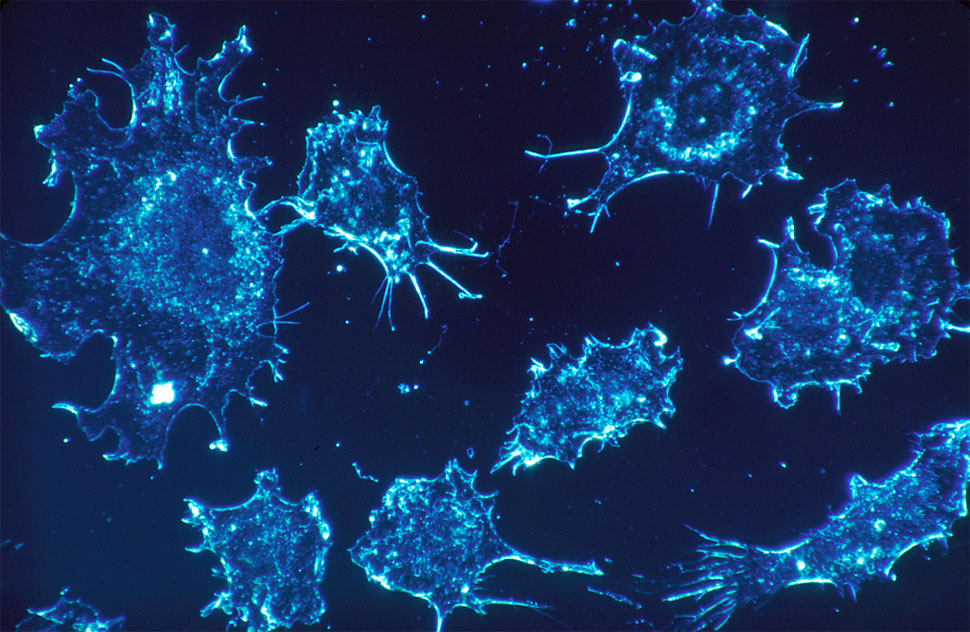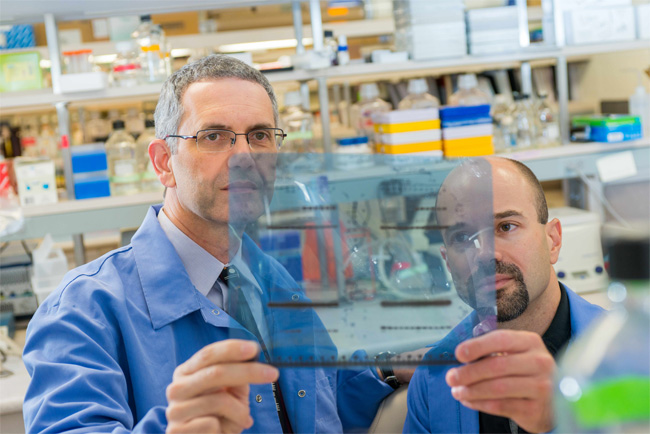
29th August 2015 Scientists find possible "off switch" for cancer A new way of "switching off" cancer cell growth, based on adhesion proteins, is reported by the Mayo Clinic.
Researchers at the Mayo Clinic in Florida have discovered a way to potentially reprogram cancer cells back to normal cells. This finding, published in the journal Nature Cell Biology, represents "an unexpected new biology that provides the code, the software for turning off cancer," says the study's senior investigator, Panos Anastasiadis, Ph.D., chair of the Department of Cancer Biology. His team experimented with human cells in the laboratory that were affected with breast, lung and bladder cancer. Normal cells are prevented from uncontrolled growth by adhesion proteins – a special "glue" that keeps cells together. The Mayo team discovered that this glue – which consists primarily of E-cadherin and p120 catenin – is controlled by biological microprocessors known as microRNAs that in turn use another protein called PLEKHA7 for regulation. In other words: when normal cells come into contact with each other, genes that promote cell growth are suppressed by this specific subset of microRNAs. Cancer cells, on the other hand, were shown to be missing PLEKHA7. Restoring either its level or increasing the level of microRNAs within these cells turned them back into a benign state. "We believe that loss of the apical PLEKHA7-microprocessor complex is an early and somewhat universal event in cancer," says Dr. Anastasiadis. "In the vast majority of human tumour samples we examined, this apical structure is absent, although E-cadherin and p120 are still present. This produces the equivalent of a speeding car that has a lot of gas (the bad p120) and no brakes (the PLEKHA7-microprocessor complex). "By administering the affected microRNAs in cancer cells to restore their normal levels, we should be able to re-establish the brakes and restore normal cell function," he adds. "Initial experiments in some aggressive types of cancer are indeed very promising."
"The study brings together two so-far unrelated research fields – cell-to-cell adhesion and miRNA biology – to resolve a long-standing problem about the role of adhesion proteins in cell behaviour that was baffling scientists," says Antonis Kourtidis, Ph.D., an associate of Dr. Anastasiadis. "Most significantly, it uncovers a new strategy for cancer therapy." "When this apical adhesion complex was disrupted after loss of PLEKHA7, this set of microRNAs was misregulated – and the E-cadherin and p120 switched sides to become oncogenic," he adds. The team is now working on better options for delivering the molecules. In the future, an injection could be developed that sends the microRNA directly into cells or tumours, without the need for harsh chemotherapy or additional surgery methods. Experts not involved in the research note its importance, but appear sceptical about its possible effectiveness in treatments. "This important study solves a long-standing biological mystery – but we mustn't get ahead of ourselves," said Henry Scowcroft, the senior science information manager at Cancer Research UK. "There's a long way to go before we know whether these findings, in cells grown in a laboratory, will help treat people with cancer. But it's a significant step forward in understanding how certain cells in our body know when to grow, and when to stop. Understanding these key concepts is crucial to help continue the encouraging progress against cancer we've seen in recent years." "I think in reality, it is unlikely that you could reverse tumours by reversing just one mechanism, but it's a very interesting finding," concluded Dr. Chris Bakal from the Institute for Cancer Research in London.
Comments »
|








